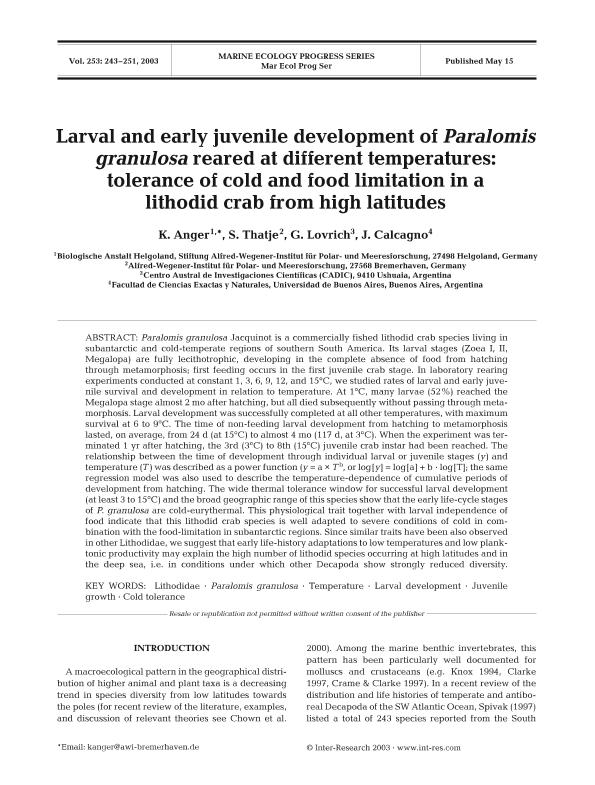Artículo
Larval and early juvenile development of Paralomis granulosa reared at different temperatures: Tolerance of cold and food limitation in a lithodid crab from high latitudes
Fecha de publicación:
05/2003
Editorial:
Inter-Research
Revista:
Marine Ecology Progress Series
ISSN:
0171-8630
Idioma:
Inglés
Tipo de recurso:
Artículo publicado
Clasificación temática:
Resumen
Paralomis granulosa Jacquinot is a commercially fished lithodid crab species living in subantarctic and cold-temperate regions of southern South America. Its larval stages (Zoea I, II, Megalopa) are fully lecithotrophic, developing in the complete absence of food from hatching through metamorphosis; first feeding occurs in the first juvenile crab stage. In laboratory rearing experiments conducted at constant 1, 3, 6, 9, 12, and 15°C, we studied rates of larval and early juvenile survival and development in relation to temperature. At 1°C, many larvae (52%) reached the Megalopa stage almost 2 mo after hatching, but all died subsequently without passing through metamorphosis. Larval development was successfully completed at all other temperatures, with maximum survival at 6 to 9°C. The time of non-feeding larval development from hatching to metamorphosis lasted, on average, from 24 d (at 15°C) to almost 4 mo (117 d, at 3°C). When the experiment was terminated 1 yr after hatching, the 3rd (3°C) to 8th (15°C) juvenile crab instar had been reached. The relationship between the time of development through individual larval or juvenile stages (y) and temperature (T) was described as a power function (y = a × Tb, or log[y] = log[a] + b · log[T]; the same regression model was also used to describe the temperature-dependence of cumulative periods of development from hatching. The wide thermal tolerance window for successful larval development (at least 3 to 15°C) and the broad geographic range of this species show that the early life-cycle stages of P. granulosa are cold-eurythermal. This physiological trait together with larval independence of food indicate that this lithodid crab species is well adapted to severe conditions of cold in combination with the food-limitation in subantarctic regions. Since similar traits have been also observed in other Lithodidae, we suggest that early life-history adaptations to low temperatures and low planktonic productivity may explain the high number of lithodid species occurring at high latitudes and in the deep sea, i.e. in conditions under which other Decapoda show strongly reduced diversity.
Archivos asociados
Licencia
Identificadores
Colecciones
Articulos(CADIC)
Articulos de CENTRO AUSTRAL DE INVESTIGACIONES CIENTIFICAS
Articulos de CENTRO AUSTRAL DE INVESTIGACIONES CIENTIFICAS
Citación
Anger, K.; Thatje, S.; Lovrich, Gustavo Alejandro; Calcagno, J.; Larval and early juvenile development of Paralomis granulosa reared at different temperatures: Tolerance of cold and food limitation in a lithodid crab from high latitudes; Inter-Research; Marine Ecology Progress Series; 253; 5-2003; 243-251
Compartir
Altmétricas




